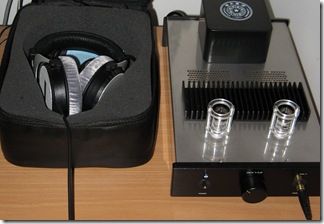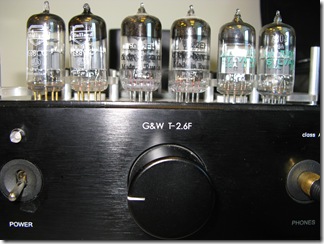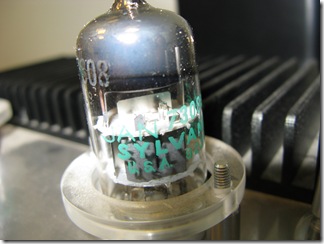Note: This is more or less a translation of two forum posts in an Israeli home theater website; if you can read Hebrew, you may be interested in the comments as well. First post, second post
 Lately I have been bit by the audio bug again, and have decided to experiment with my headphone setup. This is the setup I use at work and listen to for hours at a time (often 5 or more hours a day), and which consists of a pair of 2003 model Beyerdynamic DT880 cans I bought on a previous trip to China, hooked up to a G&W T-2.6F amp I bought on the same trip after having spent an hour listening to various equipment combinations. Unlike products from other, internationally recognized brands with which I am familiar (Creek, Musical Fidelity etc.) this product was completely out of my comfort zone: a Chinese-made amplifier, which like many others I normally associate with cheap components and subpar build quality. Additionally it is rather large and bulky, and to top it off, it is a hybrid design based on two Electro Harmonix 6922EH preamplifier tubes and a solid state power section. Up until that point I had heard solid state equipment exclusively, with the exception of two loudspeaker demonstrations in which the amplification included tube components and was significantly more expensive than I could even consider. Since I had not known what to expect I could not detect the subtleties of tube sound, and had chosen this headphone/amp combination strictly on being the best I had heard during that visit.
Lately I have been bit by the audio bug again, and have decided to experiment with my headphone setup. This is the setup I use at work and listen to for hours at a time (often 5 or more hours a day), and which consists of a pair of 2003 model Beyerdynamic DT880 cans I bought on a previous trip to China, hooked up to a G&W T-2.6F amp I bought on the same trip after having spent an hour listening to various equipment combinations. Unlike products from other, internationally recognized brands with which I am familiar (Creek, Musical Fidelity etc.) this product was completely out of my comfort zone: a Chinese-made amplifier, which like many others I normally associate with cheap components and subpar build quality. Additionally it is rather large and bulky, and to top it off, it is a hybrid design based on two Electro Harmonix 6922EH preamplifier tubes and a solid state power section. Up until that point I had heard solid state equipment exclusively, with the exception of two loudspeaker demonstrations in which the amplification included tube components and was significantly more expensive than I could even consider. Since I had not known what to expect I could not detect the subtleties of tube sound, and had chosen this headphone/amp combination strictly on being the best I had heard during that visit.
 This setup was, in turn, hooked via a generic interconnect to my work computer with onboard HD audio, through which I play mostly lossless rips from my own CDs via Exact Audio Copy. It had faithfully served me for over three years, at which point I decided to do some research and was first exposed to the vast world of tube-based amplification and tube rolling. After several days of forum lurking and reading well into the night I had placed my first ever tube order at thetubestore.com. With the help of the shop representative, Jon, and general recommendations around the web, I had selected a matched pair of JAN-Sylvania 7308 tubes and yet another matched pair of Mullard E88CC tubes and placed my order. I did not have to wait very long, as the UPS delivery arrived amazingly fast (a single weekend, not too shabby for an international delivery!), and decided to spend a few weeks with each pair to be able to form an honest, educated opinion. I begun my experiments with what is, according to general consensus, the weaker tube: the JAN-Sylvania 7308.
This setup was, in turn, hooked via a generic interconnect to my work computer with onboard HD audio, through which I play mostly lossless rips from my own CDs via Exact Audio Copy. It had faithfully served me for over three years, at which point I decided to do some research and was first exposed to the vast world of tube-based amplification and tube rolling. After several days of forum lurking and reading well into the night I had placed my first ever tube order at thetubestore.com. With the help of the shop representative, Jon, and general recommendations around the web, I had selected a matched pair of JAN-Sylvania 7308 tubes and yet another matched pair of Mullard E88CC tubes and placed my order. I did not have to wait very long, as the UPS delivery arrived amazingly fast (a single weekend, not too shabby for an international delivery!), and decided to spend a few weeks with each pair to be able to form an honest, educated opinion. I begun my experiments with what is, according to general consensus, the weaker tube: the JAN-Sylvania 7308.
What a shock! While I do not, for a moment, assert that similar or better sound cannot be found in solid state amplifiers, I certainly did not expect such a dramatic difference in sound quality. The soundstage, previously wide but shallow, simply exploded! It’s as though the sound instantly multiplied its volume tenfold or more; highs became wonderfully airy and distinct, and the resolution… let me put it this way: in every audio enthusiast’s life there are but few such moments of enlightenment, where you suddenly realize how much more is possible, and even attainable. The first time I’ve listened to the very same equipment with upgraded tubes provided me with one of those rare occasions, and from that point on I can never settle for less.
 At the same time I had a second such revelation, albeit by accident: because of the physical layout of my desktop at work I was forced to place the amp further away from the computer, which necessitated a longer interconnect cable. I did not have one at hand and until I was done for the day I was left with no alternative but to use the iPod’s standard analog output. The iPod is generally considered to have very poor analog performance, which is why I was thoroughly surprised when, having brought a longer (and higher quality) interconnect from home and hooked the computer up, I found that the iPod actually sounded better. I recall when it was almost impossible to find a decent quality audio card for your computer, and assumed that contemporary solutions were at least adequate; indeed, the computer sound output was cleaner (better SNR) but also had significantly diminished dynamic range and volume. This led me to the conclusion that an audio card upgrade was in order.
At the same time I had a second such revelation, albeit by accident: because of the physical layout of my desktop at work I was forced to place the amp further away from the computer, which necessitated a longer interconnect cable. I did not have one at hand and until I was done for the day I was left with no alternative but to use the iPod’s standard analog output. The iPod is generally considered to have very poor analog performance, which is why I was thoroughly surprised when, having brought a longer (and higher quality) interconnect from home and hooked the computer up, I found that the iPod actually sounded better. I recall when it was almost impossible to find a decent quality audio card for your computer, and assumed that contemporary solutions were at least adequate; indeed, the computer sound output was cleaner (better SNR) but also had significantly diminished dynamic range and volume. This led me to the conclusion that an audio card upgrade was in order.
A little research into the subject brought me to the the conclusion that what I’m interested in is not, in fact, a computer audio card; what I want is an external DAC, or more specifically a USB DAC. Getting a computer to output even half-decent analog audio is pretty much a futile quest, and while hooking it up via coaxial/optical S/PDIF would certainly work there are some significant disadvantages, namely: digital (lossy) volume control, and jitter. With S/PDIF, both clock and data signals are encoded together on a single data line, and the click has to be regenerated. This introduces subtle timing inaccuracies, generally known as jitter, which in have an undesirable impact on digital-to-analog conversion (a more scientific explanation can be found here). Just how significant an impact is a subject of much controversy, but at a USB DAC has the theoretical advantage of significantly reduced jitter on the protocol level, as well as removing the question of the onboard S/PDIF encoder’s clock accuracy from the equation.
 With the advice of fellow forum members I resolved to try one of the following DAC trio: Cambridge Audio DacMagic, Oritek OMZ DAC or Musical Fidelity V-DAC. Following a lead from a fellow forum member I eventually bought the V-DAC for a very good price from a head-fi.org forum member. The V-DAC is a 192KHz/24-bit upsampling DAC with optical, coaxial and USB inputs that has received high praise in the head-fi circles and is even available in Israel for a surprisingly reasonable price.
With the advice of fellow forum members I resolved to try one of the following DAC trio: Cambridge Audio DacMagic, Oritek OMZ DAC or Musical Fidelity V-DAC. Following a lead from a fellow forum member I eventually bought the V-DAC for a very good price from a head-fi.org forum member. The V-DAC is a 192KHz/24-bit upsampling DAC with optical, coaxial and USB inputs that has received high praise in the head-fi circles and is even available in Israel for a surprisingly reasonable price.
 I hooked the unit up with an unnamed but high quality silver interconnect, and after significant critical listening I can draw the following conclusions: compared with both iPod and onboard audio card (as well as an old Audigy 4 I had lying around) the V-DAC features significantly improved accuracy and resolution, and more and more often I’ve been rewinding tracks just to make sure that, yes, I wasn’t imagining, I really have never heard this or that detail before. This is exactly what I got into audio for in the first place! The bass is also much tighter, and in my opinion also extends further down than it ever did. In fact, the only disadvantage is in a certain change in the soundstage, as though the stereo separation grew just a littler wider than I’d like. Don’t get me wrong, the soundstage is huge and imaging is terrific, but it sometimes seems to be that sounds tend to cluster a little closer to the extremes of the soundstage than they should.
I hooked the unit up with an unnamed but high quality silver interconnect, and after significant critical listening I can draw the following conclusions: compared with both iPod and onboard audio card (as well as an old Audigy 4 I had lying around) the V-DAC features significantly improved accuracy and resolution, and more and more often I’ve been rewinding tracks just to make sure that, yes, I wasn’t imagining, I really have never heard this or that detail before. This is exactly what I got into audio for in the first place! The bass is also much tighter, and in my opinion also extends further down than it ever did. In fact, the only disadvantage is in a certain change in the soundstage, as though the stereo separation grew just a littler wider than I’d like. Don’t get me wrong, the soundstage is huge and imaging is terrific, but it sometimes seems to be that sounds tend to cluster a little closer to the extremes of the soundstage than they should.
All in all I’m extremely happy with the upgrade, and luckily I still have some new equipment left to play with: the Mullard E88CC tubes, patiently awaiting my pleasure. Still, now that there’s such a significant difference in fidelity between my work and home setup (which consists of an Aqua Mini-Head amp and Beyerdynamic DT880 2005 edition cans) I feel compelled to experiment with new equipment. Whatever shall I try next, a new DAC? Another amp? Different cans, perhaps? The choices are endless, and that’s the beauty of it. See you on the next upgrade.
Update: Some more pictures can be found here.